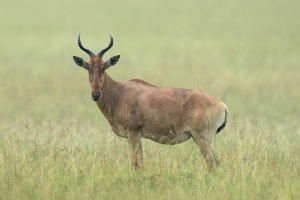
The Alcelaphus buselaphus, commonly known as the hartebeest, is a large African antelope distinguished by its elongated face, distinctive horns, and impressive adaptability to challenging environments.
Hartebeests are among the oldest surviving antelope species and play a key role in maintaining the balance of African grassland ecosystems.
Physical Characteristics
Hartebeests possess a unique physique with a long, narrow face, a sloped back, and high shoulders. Their reddish-brown coats feature black markings on the forehead and tail. Standing around 1.2 meters (4 feet) tall at the shoulder and weighing between 100 to 200 kilograms (220-440 pounds), these antelopes are well-built for endurance. Both males and females sport horns, which can reach up to 60 centimeters (24 inches) in length and curve in a distinctive V-shape.
Habitat and Range
Hartebeests are native to various parts of Africa, spanning grasslands, savannas, and open plains. They are highly adaptable, inhabiting areas ranging from dry regions to lush savannas. Their range extends across sub-Saharan Africa, where they are often seen grazing in large herds, though some populations occupy the more arid zones, relying on their endurance to traverse long distances in search of food.
Behavior and Diet
Hartebeests are primarily grazers, feeding on grasses and occasionally browsing on shrubs. They exhibit selective grazing, often consuming nutrient-rich grasses that sustain them through dry seasons. Known for their stamina, hartebeests can run at moderate speeds for long durations to evade predators. However, they are not particularly fast over short distances, making them somewhat vulnerable to lions, cheetahs, and hyenas.
Reproduction and Lifecycle
The mating season for hartebeests varies depending on their region, but it usually aligns with the end of the rainy season when resources are abundant. After a gestation period of around eight months, females give birth to a single calf, which can stand and walk within minutes after birth. Calves remain hidden for a few days to avoid predators before joining the herd. Hartebeests reach maturity at around two to three years old, with a typical lifespan of 12 to 15 years in the wild.
Conservation Status
The conservation status of hartebeests varies by subspecies, with some populations listed as Least Concern and others classified as Endangered due to habitat loss, hunting, and competition with livestock. Conservation efforts focus on habitat preservation and protecting areas where these antelopes are vulnerable. Hartebeests play a crucial role in their ecosystems, as their grazing patterns help maintain grassland health and biodiversity.
Fascinating Facts
Speed and Endurance: While they aren't the fastest antelopes, hartebeests can maintain a steady pace for long distances.
Multiple Subspecies: There are several subspecies of hartebeests, each adapted to different regions of Africa.
Alert Grazers: Hartebeests often take turns watching for predators while others in the herd graze, ensuring the group’s safety.
Lykkers, The hartebeest is a remarkable example of adaptability and resilience. Its distinct features, social behavior, and ecological role make it a vital component of Africa's grassland ecosystems. As efforts continue to preserve African wildlife, the hartebeest serves as a reminder of the importance of protecting biodiversity and natural habitats.
The African Hartebeest (Alcelaphus buselaphus)
Video by Nature and Animals


